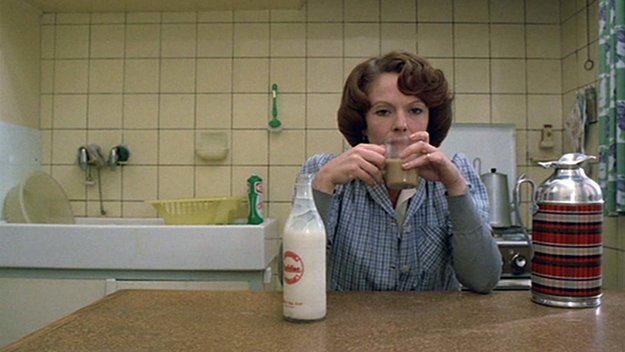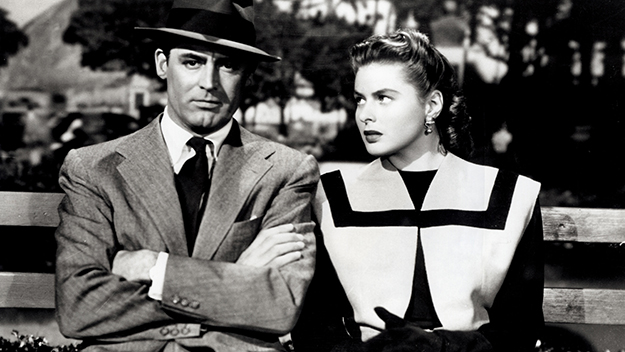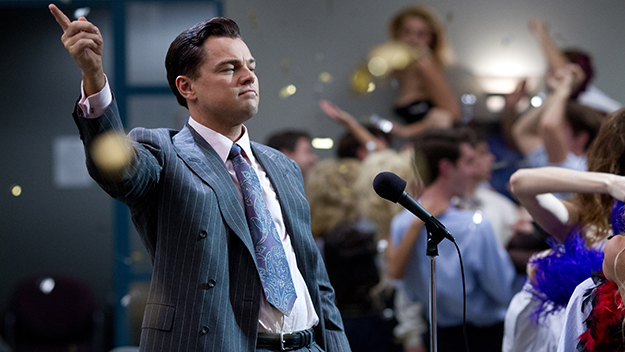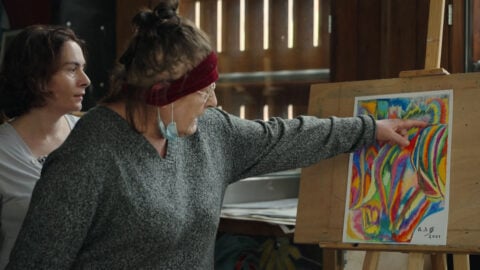Present Tense: Audience vs. Alone
Present Tense is a column by Sheila O’Malley that reflects on the intersections of film, literature, art, and culture.

Jeanne Dielman, 23, quai du Commerce, 1080 Bruxelles (Chantal Akerman, 1976)
The first time I saw Chantal Akerman’s Jeanne Dielman, 23, quai du Commerce, 1080 Bruxelles was years ago in a packed theater in Chicago. The film came weighted by its own reputation. I went in intimidated (I had found much of the writing about it to be incomprehensible, albeit intriguing). I have seen the film many times since, but when I think about the first time I remember one thing and one thing only: when Delphine Seyrig, busy in her cooking routine, dropped a fork, a woman a couple of rows away from me, who was also probably seeing it for the first time, gasped in terror. I had been completely wrapped up in the film, but when the woman gasped, at the most mundane sight imaginable, I suddenly understood Jeanne Dielman’s towering reputation on a visceral level. Dazzled, I thought to myself, “My God, everyone was right, this is a stone-cold masterpiece.” It’s possible I would have come to the same conclusion if I had seen the film alone in my apartment, but it would have been a very different experience.
Seeing a film with an audience is rare now, for multiple intersecting reasons, technological and social. We lose much when we don’t come together for what Walter Benjamin called a “simultaneous collective experience.” There’s something profound about surrendering personal distractions, conversation, all other activities, to submit to a fictional story. It’s a unique kind of concentration. Any actor who does live theater will tell you there is nothing quite like the sound of a large group of people listening intently. Listening like that has feel and texture. Actors know when they lose an audience. They can sense the change in energy. Watching a movie surrounded by strangers, and watching a movie in the privacy of your home are different experiences. Both have pros and cons. Live audiences can be annoying. People look at their phones, talk, etc. (That said, the ideal of watching a movie in a sacral state of rapt silence is an extremely recent phenomenon. Try yearning for rapt silence at The Globe Theatre in 1601. Good luck!) But there is nothing quite like a group of strangers becoming one. I remember the Jeanne Dielman audience with fondness. We went through something together.
Audiences can gel together, can rupture the so-called “fourth wall,” can merge into a collective whole—either positively inclined or negatively—with an eruption of response. Famous stories of rowdy audiences travel down to us through time, theater providing more examples merely because it’s been around longer than cinema. An audience can let a playwright know in no uncertain terms his or her message has landed. On January 6, 1935, the first production of Clifford Odets’ Waiting for Lefty was just one act in a crowded bill put together by the League of Workers Theatres to support the New Theatre. Waiting for Lefty was written as propaganda supporting the New York taxi drivers who were organizing a strike. No one who was there that night ever forgot it. The play ends with the news that chairman “Lefty” has been killed, and cast members, including Odets, placed out in the audience, started chanting, “Strike! Strike! Strike!” Suddenly, electrically, the audience took up the cry, screaming “Strike” over and over, charging onto the stage, surrounding the cast, and then pouring out into the streets, screaming “Strike!” Odets said much later: “You saw theater in its truest essence. Suddenly the proscenium arch of the theatre vanished and the audience and actors were at one with each other.” The great Ruth Nelson, who played Edna in the production remembered: “When they couldn’t applaud anymore, they stomped their feet. All I could think was, ‘My God, they’re going to break the balcony down!’ It was terrible, it was so beautiful.”

Notorious (Alfred Hitchcock, 1946)
The experience of going to the movies isn’t as immediate as live theater, there isn’t the same spark of potential danger. Whatever is on screen is “in the can,” there aren’t live humans up there, what you are looking at on screen is already in the past. This is even more obvious when you’re watching an “old film.” Everyone on screen is long dead. You in the audience are alive. Sometimes watching old movies in a theatrical setting is a disheartening experience. People snicker at the different acting style, treat melodrama as camp, or like a glorified Mystery Science Theater 3000 episode. But when it clicks, suddenly a 2019 audience merges with a 1938 audience, a 1942 audience, and we’re laughing at the same things, moved by the same things. When I went to see Notorious at the Film Forum some years ago (the first time I’d seen it on a big screen), the audience started out in a restless mood, snickering at some of the line readings, determined not to take it seriously. At some point, though, the group got swept up in the story. During the scene in the wine cellar, when Cary Grant’s “Devlin” accidentally breaks the bottle, a woman in the audience screamed at the top of her lungs. In the final standoff with the Nazis, the tension in the theater was palpable, and everyone burst into applause as Bergman and Grant made their getaway. It was an exhilarating turn-around. Notorious is one of my favorite movies, and re-watching it now is enriched by the memory of that Film Forum audience.
One of the most memorable movie experiences of my life was seeing Do the Right Thing on its opening weekend in a crowded theater in Philadelphia. The feeling in the room was so jagged and intense, I thought of Waiting for Lefty, of the obliteration of the fourth wall, of audience and movie merging. People were shouting things out, sobbing, laughing, but also murmuring among themselves, in a kind of seething engagement. While Do the Right Thing “registers” wherever you see it and in whatever circumstance, for me it would be absolutely unthinkable to have seen it for the first time any other way.

The Wolf of Wall Street (Martin Scorsese, 2013)
An audience can merge with a movie in a strange alchemy, becoming so much a part of the experience that the work itself seems altered when you revisit it in another context. I saw Wolf of Wall Street during its opening weekend in Hoboken, New Jersey. It was a sold-out show. Similar to the feeling in the theater for Do the Right Thing, the audience buzzed with anticipation, nervous energy ricocheting around. This was a remarkably responsive audience. It picked up on everything, it responded to the subtle and the broad. It listened closely, it missed nothing, it picked up on tiny behavioral moments, and it howled with laughter at Leonardo DiCaprio’s tour de force Quaalude-induced performance-art piece. Once the pills “hit” DiCaprio’s system, the laughter started. We had been primed for it, so the first level was the laughter of satisfied expectations: “Oh, here we go, we knew this was coming!” But when the scene kept going… and going… and going, the laughter changed with it, deepening, broadening, cracking through any remaining reticence, until finally the entire audience was a heaving mass of rocking roaring maniacs. People were still laughing 15 minutes after the scene was over.
The strangest thing happened when I watched Wolf of Wall Street a second time, a year or so later, alone in my apartment. The movie was the same, but the mood was so totally different I actually questioned my initial response. Both versions worked, albeit in completely different ways. If with an audience the Quaalude scene played in a major key, like a whacked-out “76 Trombones,” then alone in my apartment it was all minor-key chords, alienated and mournful. DiCaprio’s writhing rubbery body was no longer hilarious and outrageous; it seemed instead to be an abstract pantomime of the absurdity of life, an existential movement-piece on the grotesquerie of excess.
Both versions worked, but in opposite ways. Watching Wolf of Wall Street with an audience felt like the best of live theater: it was as though DiCaprio could hear our laughter, and was feeding off of it, using it to push himself further, give us more of what we so obviously wanted (and not just wanted, but needed). Watching it alone gave me the space to admire DiCaprio’s physical work (second to none), and to think about the risks director and actor took with such an extreme sequence. To create such a sequence in a vacuum—without an audience present, but trusting the eventual audience to respond in the way you want them to respond—is an extraordinary thing.
When Peter Bogdanovich interviewed Alfred Hitchcock, he said, “You never watch your films with an audience—don’t you miss hearing them scream?” Hitchcock replied, “No. I can hear them when I’m making the picture.”
Sheila O’Malley is a regular film critic for Rogerebert.com and other outlets including The Criterion Collection. Her blog is The Sheila Variations.







